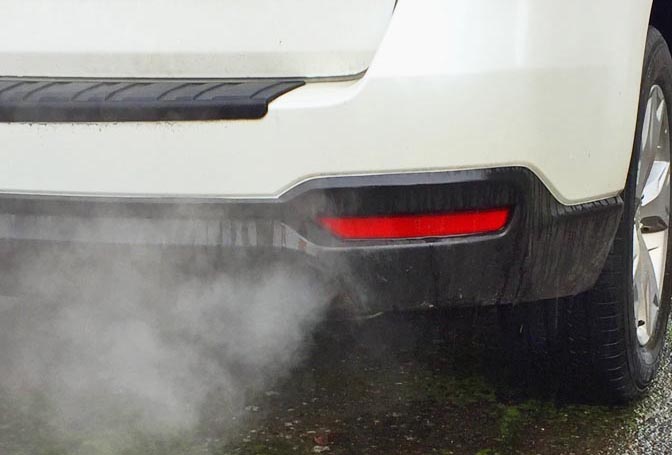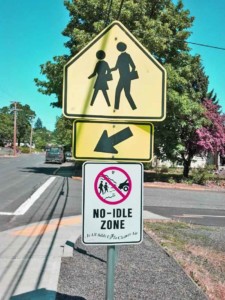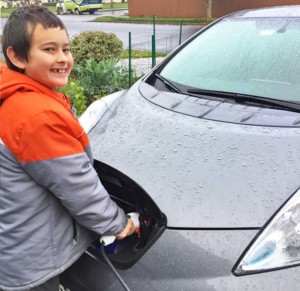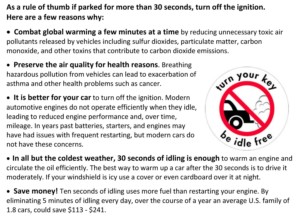By Miko Ruhlen. Nov. 28, 2016.
My younger son loves to backseat drive. Several weeks ago, I explained that from now on, I’ll turn the car off while waiting for big brother, rather than let the car idle. He happily took on the job to be my personal ‘policeman’ when I forget.
It helps to have accountability when trying to break a habit.
I’m pretty conscientious about not letting the car idle for long periods, but I’d started noticing that the 30 seconds that I thought it took for my son to run back for a book he forgot, actually took 5 minutes. The 60 seconds to run into and leave something at a friend’s house (and wind up chatting) took another 5 minutes.
While a few minutes of vehicle idling seems like a negligible impact, cumulatively, all those minutes add lots of carbon dioxide to the environment and to the air we breathe.
For every 10 minutes I spend not idling, I prevent one pound of carbon dioxide from being released. Carbon dioxide is the primary contributor to global warming. We Americans, as a whole, may be burning as much as 3.8 million gallons of gas idling every day. Annually, idling adds 1.4 billion gallons of gasoline and 13 million tons of carbon dioxide.
Children are the most sensitive to vehicle exhaust due to their developing lungs and more rapid breathing–leading to inhaling more pollutants per pound of body mass than adults. Since many children need to be picked up from schools by bus or parents, idling is common in school loading zones.

Sign in front of Whitson Elementary School, White Salmon
The White Salmon Valley School District bus drivers’ training includes a video about vehicle exhaust, the negative health impacts to children, and the district’s anti-idling policy. “After initial safety inspections are complete, if they [the buses] are to sit more than two minutes they need to turn their bus off,” says Susan Tibke, District Transportation Supervisor. Passenger loading zones are near the school’s air intakes, so vehicle exhaust can enter the classrooms–one reason they are vigilant.
They installed signs designating no-idling zones in 2007 on streets adjacent to the school buildings. Tibke recalled that when former transportation director Sharon Schalk went to a transportation conference that year, “…the next thing I knew, this guy from the conference was pulling these signs out of his trunk and giving them to us, and so we had the maintenance guys put them up.”
Tibke said that initially people obeyed the signs, but as with a lot of things, people stop seeing it after a while. Ray Fazer, the crossing guard at Whitson Elementary, says he lets people know they shouldn’t be idling, whenever he can, “Most people obey the sign, but there are probably some new ones that don’t know, so I tell them–unless they are across the street, and I can’t get to them in time.”
In 2011, the district received an idle-reduction grant from the Washington Department of Ecology. The grant paid to have fuel-operated heaters installed on 12 buses. These heaters turn on a timer a half hour before running to help them warm up without idling, The heaters use about a tablespoon of diesel.
Wasco County School District also has an anti-idling policy for buses. Debbie Park, the transportation director there says, “It’s [idling] hard on the buses and hard on the environment. We have had a non-idling policy for buses for quite some time. When buses are parked and waiting in a loading zone, they are to be shut off. ”
Some school districts, such as Hood River County School District, do not have a school board policy, but they have “in-house practices that are self-governed and established in the department,” according to Don Benefield, transportation supervisor for the district. Under normal conditions, the district does not allow idling, however when it is really cold, buses may idle for a short time if needed to keep the bus temperature habitable.
Neither Wasco or Hood River County school districts have policies against idling for parents dropping off and picking up children.
Over 13 states have recognized the impacts of idling and have anti-idling campaigns. There are also anti-idling initiatives in other countries such as Japan, Canada, and Great Britain. Because of the impact on children, a lot of anti-idling campaigns focus on schools.

Author’s son charging electric car.
Getting children involved is a great way to make an impact on local idling policies. The EPA has a toolkit available for kids to start a student-run (or parent/teacher led) awareness campaign in their school or community or a related science project. It comes complete with a cute logo and slogan: ‘Turn your key. Be idle free.’
As for myself, I plan to make myself a sticker chart with rewards every time I save the planet 10 pounds of carbon dioxide, because I idled 10 minutes less than before. Or maybe I will treat myself to 10 minutes of yoga and meditation instead. My son now prefers to skip the whole thing and just ride in my husband’s new electric car charged by rooftop solar panels for a better solution. Plus as he says, “Dads are cooler.”






